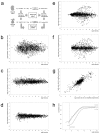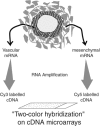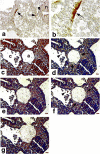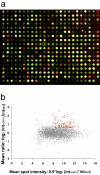mRNA expression profiling of laser microbeam microdissected cells from slender embryonic structures
- PMID: 11891179
- PMCID: PMC1867164
- DOI: 10.1016/S0002-9440(10)64903-6
mRNA expression profiling of laser microbeam microdissected cells from slender embryonic structures
Abstract
Microarray hybridization has rapidly evolved as an important tool for genomic studies and studies of gene regulation at the transcriptome level. Expression profiles from homogenous samples such as yeast and mammalian cell cultures are currently extending our understanding of biology, whereas analyses of multicellular organisms are more difficult because of tissue complexity. The combination of laser microdissection, RNA amplification, and microarray hybridization has the potential to provide expression profiles from selected populations of cells in vivo. In this article, we present and evaluate an experimental procedure for global gene expression analysis of slender embryonic structures using laser microbeam microdissection and laser pressure catapulting. As a proof of principle, expression profiles from 1000 cells in the mouse embryonic (E9.5) dorsal aorta were generated and compared with profiles for captured mesenchymal cells located one cell diameter further away from the aortic lumen. A number of genes were overexpressed in the aorta, including 11 previously known markers for blood vessels. Among the blood vessel markers were endoglin, tie-2, PDGFB, and integrin-beta1, that are important regulators of blood vessel formation. This demonstrates that microarray analysis of laser microbeam micro-dissected cells is sufficiently sensitive for identifying genes with regulative functions.
Figures






Similar articles
-
Gene expression profiling in embryonic mouse lenses.Mol Vis. 2006 Dec 26;12:1692-8. Mol Vis. 2006. PMID: 17213798
-
Neural crest and mesoderm lineage-dependent gene expression in orofacial development.Differentiation. 2007 Jun;75(5):463-77. doi: 10.1111/j.1432-0436.2006.00145.x. Epub 2007 Feb 5. Differentiation. 2007. PMID: 17286603
-
Global expression profiling of RNA from laser microdissected cells at fungal-plant interaction sites.Methods Mol Biol. 2011;712:263-81. doi: 10.1007/978-1-61737-998-7_20. Methods Mol Biol. 2011. PMID: 21359814
-
Gene profiling of laser-microdissected brain regions and individual cells in drug abuse and schizophrenia research.Methods Mol Biol. 2012;829:541-50. doi: 10.1007/978-1-61779-458-2_34. Methods Mol Biol. 2012. PMID: 22231837 Review.
-
Laser micromanipulation systems as universal tools in cellular and molecular biology and in medicine.Cell Mol Biol (Noisy-le-grand). 1998 Jul;44(5):735-46. Cell Mol Biol (Noisy-le-grand). 1998. PMID: 9764744 Review.
Cited by
-
Effects of mRNA amplification on gene expression ratios in cDNA experiments estimated by analysis of variance.BMC Genomics. 2003 Mar 23;4(1):11. doi: 10.1186/1471-2164-4-11. Epub 2003 Mar 23. BMC Genomics. 2003. PMID: 12659661 Free PMC article.
-
Evaluation of methods for amplification of picogram amounts of total RNA for whole genome expression profiling.BMC Genomics. 2009 May 26;10:246. doi: 10.1186/1471-2164-10-246. BMC Genomics. 2009. PMID: 19470167 Free PMC article.
-
Evaluating whole transcriptome amplification for gene profiling experiments using RNA-Seq.BMC Biotechnol. 2015 Jul 30;15:65. doi: 10.1186/s12896-015-0155-7. BMC Biotechnol. 2015. PMID: 26223446 Free PMC article.
-
Anatomical methods for voxelation of the mammalian brain.Neurochem Res. 2004 Jun;29(6):1299-306. doi: 10.1023/b:nere.0000023616.67996.00. Neurochem Res. 2004. PMID: 15176486
-
Macrodissection versus microdissection of rectal carcinoma: minor influence of stroma cells to tumor cell gene expression profiles.BMC Genomics. 2005 Oct 14;6:142. doi: 10.1186/1471-2164-6-142. BMC Genomics. 2005. PMID: 16225673 Free PMC article.
References
-
- Venter JC, Adams MD, Myers EW, Li PW, Mural RJ, Sutton GG, Smith HO, Yandell M, Evans CA, Holt RA, Gocayne JD, Amanatides P, Ballew RM, Huson DH, Wortman JR, Zhang Q, Kodira CD, Zheng XH, Chen L, Skupski M, Subramanian G, Thomas PD, Zhang J, Gabor Miklos GL, Nelson C, Broder S, Clark AG, Nadeau J, McKusick VA, Zinder N, Levine AJ, Roberts RJ, Simon M, Slayman C, Hunkapiller M, Bolanos R, Delcher A, Dew I, Fasulo D, Flanigan M, Florea L, Halpern A, Hannenhalli S, Kravitz S, Levy S, Mobarry C, Reinert K, Remington K, Abu-Threideh J, Beasley E, Biddick K, Bonazzi V, Brandon R, Cargill M, Chandramouliswaran I, Charlab R, Chaturvedi K, Deng Z, Di Francesco V, Dunn P, Eilbeck K, Evangelista C, Gabrielian AE, Gan W, Ge W, Gong F, Gu Z, Guan P, Heiman TJ, Higgins ME, Ji RR, Ke Z, Ketchum KA, Lai Z, Lei Y, Li Z, Li J, Liang Y, Lin X, Lu F, Merkulov GV, Milshina N, Moore HM, Naik AK, Narayan VA, Neelam B, Nusskern D, Rusch DB, Salzberg S, Shao W, Shue B, Sun J, Wang Z, Wang A, Wang X, Wang J, Wei, M, Wides R: The sequence of the human genome. Science 2001, 291:1304–1351 - PubMed
-
- Lander ES, Linton LM, Birren B, Nusbaum C, Zody MC, Baldwin J, Devon K, Dewar K, Doyle M, FitzHugh W, Funke R, Gage D, Harris K, Heaford A, Howland J, Kann L, Lehoczky J, LeVine R, McEwan P, McKernan K, Meldrim J, Mesirov JP, Miranda C, Morris W, Naylor J, Raymond C, Rosetti M, Santos R, Sheridan A, Sougnez C, Stange-Thomann N, Stojanovic N, Subramanian A, Wyman D, Rogers J, Sulston J, Ainscough R, Beck S, Bentley D, Burton J, Clee C, Carter N, Coulson A, Deadman R, Deloukas P, Dunham A, Dunham I, Durbin R, French L, Grafham D, Gregory S, Hubbard T, Humphray S, Hunt A, Jones M, Lloyd C, McMurray A, Matthews L, Mercer S, Milne S, Mullikin JC, Mungall A, Plumb R, Ross M, Shownkeen R, Sims S, Waterston RH, Wilson RK, Hillier LW, McPherson JD, Marra MA, Mardis ER, Fulton LA, Chinwalla AT, Pepin KH, Gish WR, Chissoe SL, Wendl MC, Delehaunty KD, Miner TL, Delehaunty A, Kramer JB, Cook LL, Fulton RS, Johnson DL, Minx PJ, Clifton SW, Hawkins T, Branscomb E, Predki P, Richardson P, Wenning S, Slezak T, Doggett N, Cheng JF, Olsen A, Lucas S, Elkin C, Uberbacher E, Frazier M, Gibbs RA, Muzny DM, Scherer SE, Bouck JB, Sodergren EJ, Worley KC, Rives CM, Gorrell JH, Metzker ML, Naylor SL, Kucherlapati RS, Nelson DL, Weinstock GM, Sakaki Y, Fujiyama A, Hattori M, Yada T, Toyoda A, Itoh T, Kawagoe C, Watanabe H, Totoki Y, Taylor T, Weissenbach J, Heilig R, Saurin W, Artiguenave F, Brottier P, Bruls T, Pelletier E, Robert C, Wincker P, Smith DR, Doucette-Stamm L, Rubenfield M, Weinstock K, Lee HM, Dubois J, Rosenthal A, Platzer M, Nyakatura G, Taudien S, Rump A, Yang H, Yu J, Wang J, Huang G, Gu J, Hood L, Rowen L, Madan A, Qin S, Davis RW, Federspiel NA, Abola AP, Proctor MJ, Myers RM, Schmutz J, Dickson M, Grimwood J, Cox DR, Olson MV, Kaul R, Shimizu N, Kawasaki K, Minoshima S, Evans GA, Athanasiou M, Schultz R, Roe BA, Chen F, Pan H, Ramser J, Lehrach H, Reinhardt R, McCombie WR, de la Bastide M, Dedhia N, Blocker H, Hornischer K, Nordsiek G, Agarwala R, Aravind L, Bailey JA, Bateman A, Batzoglou S, Birney E, Bork P, Brown DG, Burge CB, Cerutti L, Chen HC, Church D, Clamp M, Copley RR, Doerks T, Eddy SR, Eichler EE, Furey TS, Galagan J, Gilbert JG, Harmon C, Hayashizaki Y, Haussler D, Hermjakob H, Hokamp K, Jang W, Johnson LS, Jones TA, Kasif S, Kaspryzk A, Kennedy S, Kent WJ, Kitts P, Koonin EV, Korf I, Kulp D, Lancet D, Lowe TM, McLysaght A, Mikkelsen T, Moran JV, Mulder N, Pollara VJ, Ponting CP, Schuler G, Schultz J, Slater G, Smit AF, Stupka E, Szustakowki J, Thierry-Mieg D, Wagner L, Wallis J, Wheeler R, Williams A, Wolf YI, Wolfe KH, Yang SP, Yeh RF, Collins F, Guyer MS, Peterson J, Felsenfeld A, Wetterstrand KA, Patrinos A, Morgan MJ: Initial sequencing and analysis of the human genome. Nature 2001, 409:860-921 - PubMed
-
- Alizadeh AA, Eisen MB, Davis RE, Ma C, Lossos IS, Rosenwald A, Boldrick JC, Sabet H, Tran T, Yu X, Powell JI, Yang L, Marti GE, Moore T, Hudson Jr J, Lu L, Lewis DB, Tibshirani R, Sherlock G, Chan WC, Greiner TC, Weisenburger DD, Armitage JO, Warnke R, Levy R, Wilson W, Grever MR, Byrd JC, Botstein D, Brown PO, Staudt LM: Distinct types of diffuse large B-cell lymphoma identified by gene expression profiling. Nature 2000, 403:503–511 - PubMed
-
- White KP, Rifkin SA, Hurban P, Hogness DS: Microarray analysis of Drosophila development during metamorphosis. Science 1999, 286:2179-2184 - PubMed
-
- Schutze K, Lahr G: Identification of expressed genes by laser-mediated manipulation of single cells. Nature Biotechnol 1998, 16:737-742 - PubMed
Publication types
MeSH terms
Substances
LinkOut - more resources
Full Text Sources
Other Literature Sources
Molecular Biology Databases
Research Materials
Miscellaneous

